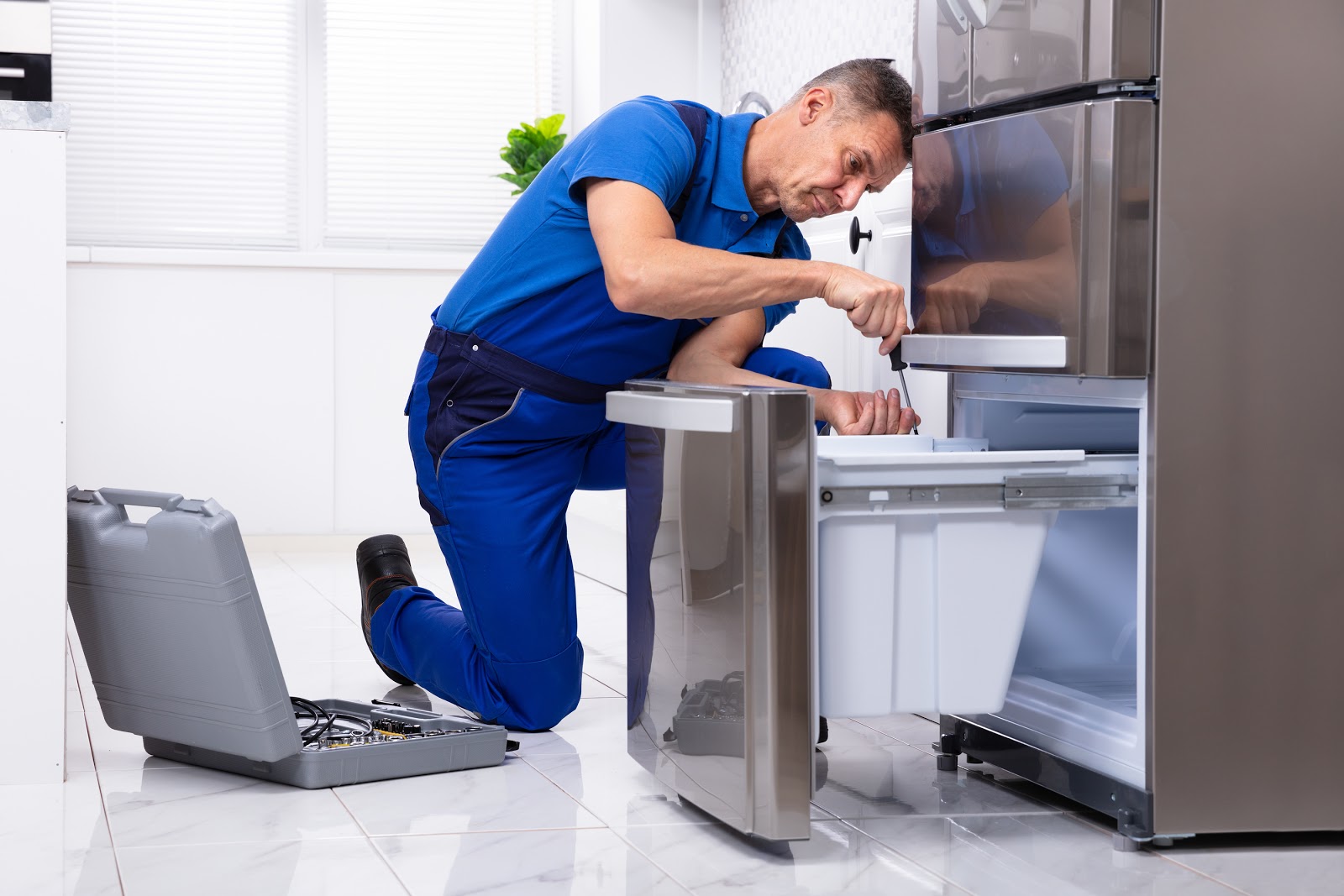Crucial Tips for Effective Ref Repair Service to Prolong Appliance Lifespan
When it comes to your fridge, correct repair work and maintenance are essential for long life. Understanding common problems and recognizing when to act can make all the distinction.
Comprehending Typical Refrigerator Troubles
Refrigerators are necessary in maintaining your food fresh, yet they can encounter an array of usual troubles that interrupt their efficiency. One constant concern is inadequate cooling. If you discover food spoiling quicker than normal, examine the thermostat settings or think about if the door seals are damaged. Another common trouble is excessive sound, which can show a malfunctioning compressor or a failing fan. You might additionally experience water pooling inside or beneath the refrigerator; this usually results from a clogged up defrost drain or a faulty water line. Furthermore, if your fridge's light isn't functioning, it could be a simple light bulb issue or a problem with the door switch. Lastly, ice build-up in the freezer can prevent air movement and cooling down effectiveness. Recognizing these issues early can conserve you time and money in repair work, guaranteeing your refrigerator runs smoothly and effectively.
Routine Upkeep Practices
To keep your home appliances running efficiently, you require to stay on top of routine upkeep practices. Clean the condenser coils, inspect the door seals, and monitor the temperature level settings to ensure peak efficiency. These easy jobs can conserve you time and money on repair work down the line.
Clean Condenser Coils On A Regular Basis
Cleaning your condenser coils routinely can substantially improve your home appliance's effectiveness. Dust and dirt build up on these coils over time, causing your device to function more difficult and consume even more energy. To keep them tidy, disconnect your appliance and meticulously get rid of any protective covers.
Inspect Door Seals
Three easy steps can assist you assure your appliance's door seals are in excellent problem. Examine the seals regularly for any type of splits, tears, or indicators of wear. These damages can cause air leakages, influencing effectiveness. 2nd, clean the seals making use of cozy, soapy water to get rid of any type of particles or gunk. A tidy seal guarantees a limited fit and much better efficiency. Lastly, carry out a basic examination by closing the door on a paper. If you can quickly pull it out without resistance, the seal could need changing. By complying with these steps, you'll maintain your appliance's efficiency and long life, conserving you cash on energy costs and fixings in the future.
Monitor Temperature Level Settings
Consistently monitoring your home appliance's temperature setups is necessary for finest performance and performance. Whether you're managing a fridge, freezer, or stove, maintaining an eye on these settings can stop numerous issues. For fridges, go for temperatures in between 35 ° F and 38 ° F; for fridges freezer, stay 0 ° F. If the temperatures are too expensive or low, your home appliance may function harder, wasting power and reducing its life expectancy. Use a thermometer to check these setups consistently, specifically after major changes, like relocating your device or changing the thermostat. If you notice changes, adjust the setups appropriately and speak with the individual guidebook for assistance. By remaining aggressive about temperature surveillance, you'll ensure your devices run smoothly and last much longer.
Troubleshooting Cooling Issues
When your refrigerator isn't cooling appropriately, it can bring about ruined food and squandered cash, so attending to the issue without delay is vital. Beginning by examining the temperature level setups to confirm they're at the recommended levels, usually around 37 ° F for the refrigerator and 0 ° F for the fridge freezer. If the setups are correct, evaluate the door seals for any kind of gaps or damage; a damaged seal can allow warm air to enter.
Inspect the condenser coils, normally situated at the back or bottom of the system. Clean them with a vacuum cleaner or brush to maximize efficiency. If issues continue, it might be time to call an expert.
Dealing With Water Leakage and Ice Accumulation
If you're taking care of water leakage or ice accumulation in your appliance, it's important to recognize the source of the trouble. By identifying where the water is coming from, you can protect against more problems and stay clear of expensive repair work. Allow's check out some reliable techniques to take on these common troubles.
Identify Leak Resources
How can you properly identify the resources of water leakage and ice accumulation in your appliances? Start by inspecting the seals and gaskets on your refrigerator and fridge freezer doors. A used or broken seal can enable warm air to go into, causing condensation and ice. Next, examine site here the drain pan and drain system for obstructions or blockages; a backed-up drain can bring about water merging. Look for any type of loosened links in the water system line, which can develop leaks. Likewise, check out the defrost drain for ice accumulation, which can interrupt proper drain. By systematically examining these areas, you'll identify the resource of the trouble, allowing you to take the needed actions to repair it and prolong your device's lifespan.
Protect Against Ice Formation
To stop ice development in your appliances, beginning by verifying the temperature settings are suitable. If your refrigerator or freezer is too cold, it can lead to extreme ice build-up. Examine the door seals on a regular basis; damaged seals can let warm air in, creating condensation and ice formation.
Keep the device well-ventilated and stay clear of congestion, as this can obstruct airflow - Appliance Repair Oro Valley Dependable Appliance Services. Consistently defrost your freezer if it does not have an automatic defrost function.
If you observe water leak, identify and take care of any obstructed drainage openings, as they can add to ice accumulation. Finally, clean the coils and validate they're operating correctly to preserve peak efficiency. Taking these actions will certainly aid prolong your device's life expectancy and efficiency.
Resolving Noisy Refrigerator Sounds
While it might appear startling, a noisy refrigerator often indicates minor issues instead than significant breakdowns. Initially, recognize the source of the noise. Typical culprits include the compressor, fans, and water lines. If you listen to a buzzing sound, it could be the compressor striving; this Look At This could just be a regular procedure audio.
Next, inspect for loose products inside. In some cases, containers or racks can rattle, developing unwanted sound. Tighten up or reposition them to remove the audios.
If you see a clicking sound, it may be the defrost timer. This is generally safe but could indicate it needs assessment.
Finally, confirm your fridge is degree. An unbalanced home appliance can produce vibrations and sound. Make use of a degree to inspect, and change the feet if needed. Attending to these concerns immediately can aid keep your fridge's efficiency and lengthen its life-span.
When to Change Parts vs. Full Replacement

However, if your device is older and experiencing multiple issues, a full substitute can be more cost-efficient. Take into consideration the expense of repairs versus the home appliance's worth. If fixings go beyond 50% of a brand-new unit's price, it's normally better to purchase a substitute. Additionally, if you observe recurring problems that maintain reoccuring, it's an indication that your home appliance has reached completion of its life. Weigh these factors meticulously to make the very best choice for your needs and budget plan.
Knowing When to Call a Professional
How can you inform when it's time to employ a specialist for home appliance repair? If you notice unusual sounds, scents, or leaks, it's a clear signal that something's incorrect. Do not ignore these signs; they frequently indicate much deeper concerns. If your device quits working altogether or often trips breaker, it's another warning.
You should additionally consider your own comfort degree with repair work. If you're unsure regarding diagnosing the trouble or lack the right devices, it's finest to connect for aid. Keep in mind, attempting complicated fixings can bring about more damage and even safety risks.

Regularly Asked Inquiries
How Usually Should I Tidy the Refrigerator Coils?
You ought to cleanse your fridge coils every 6 months. This helps preserve effectiveness and stops overheating. If you observe too much dirt or animal hair, clean them extra frequently to assure your fridge runs efficiently.

Can I Make Use Of Vinegar for Cleansing My Refrigerator?
Yes, you can utilize vinegar to clean your fridge! It's an outstanding natural cleaner that removes odors and stains. Dependable Refrigeration & Appliance Repair Refrigerator repair specialist of Oro Valley. Just mix it with water, apply it to surfaces, and clean down for a fresh, tidy refrigerator
What Temperature level Should My Fridge Be Ready To?
You ought to set your fridge to 37 ° F(3 ° C) for ideal food conservation. This temperature level keeps your food fresh while avoiding putridity, guaranteeing your grocery stores last longer and decreasing waste. It's an easy change you can make!
Does a Fridge Need to Be Leveled?
Yes, your fridge requires to be leveled. If it's uneven, it can affect cooling down performance and create excess sound. Inspect the leveling legs and adjust them to assure correct equilibrium for excellent performance.
How Can I Reduce Fridge Power Consumption?
To decrease your fridge's power consumption, maintain it tidy and well-ventilated, check door seals for leakages, set the temperature between 35-38 ° F, and prevent straining it. These steps can substantially reduce your energy expenses.